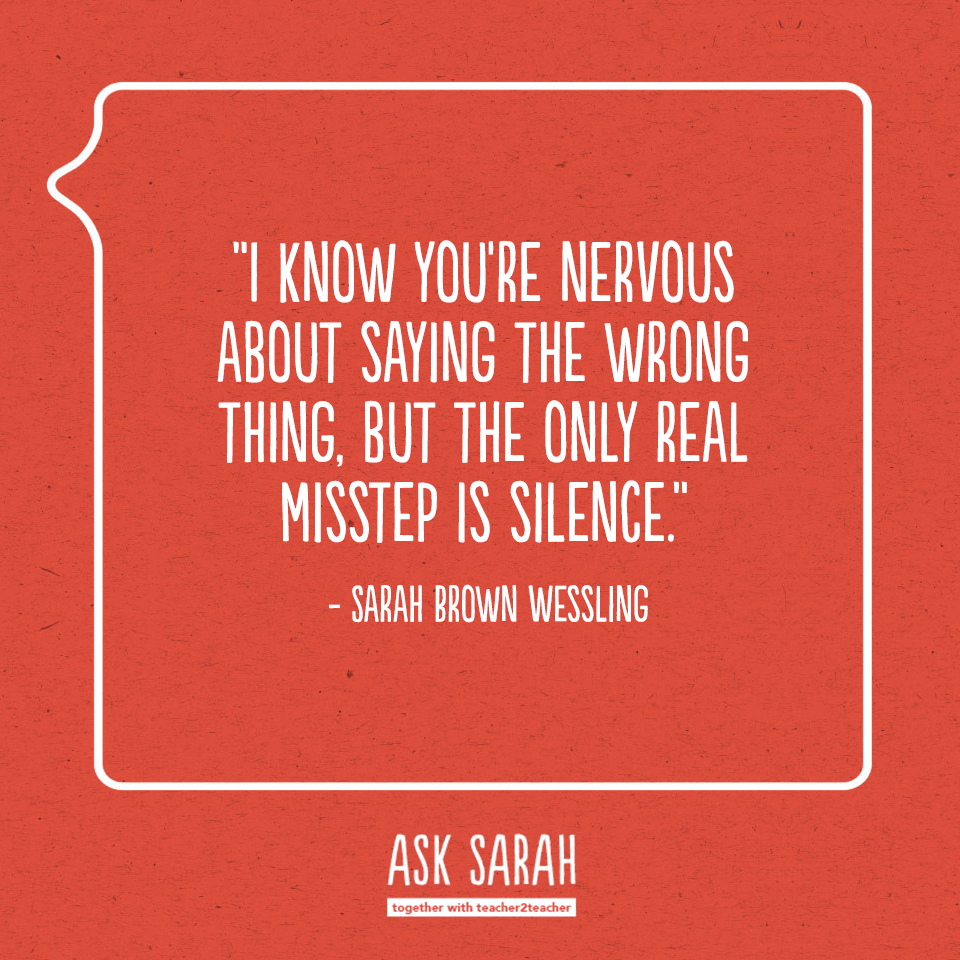

Dear Sarah,
How do you have conversations in class about topics that are uncomfortable?
Sincerely,
Tough Conversations
Dear Tough Conversations,
So many teachers, formally and informally, have voiced your question this week. Of course, it makes sense. We’re all swirling in the unknown, trying to squarely place our fears in whatever we do know: sadness or celebration, action or contemplation, rationalization or justification. We are human strings wound tightly and knotted, tangled in our perceptions, snarled in our realities. We’re doing messy human things as we pull tighter and give less.
Teachers must teach. Right now. In these toughest moments, we must do crucial work, because there aren’t tough conversations, there are only fiercely necessary ones.
I’m not just talking about the tough conversations spurred on by an election. I’m talking about big, hairy, uncomfortable talks teachers are constantly confronting. I’m talking about the one I had during my third hour class on September 11, 2001. I’m talking about the one I had in my fourth hour class the day after the boy who sat next to Mike and Jay took his life. I’m talking about the one when I had to tell Xavier he wasn’t going to graduate. I’m talking about the one when some parents were trying to ban the book my freshmen were reading and they asked if I thought it was okay. I’m talking about the one when the main character of a short story we were reading was gay and a student raised his hand and said, “That’s not okay” followed by the other student who raised his hand and replied, “Neither is what you just said.” I’m talking about the day Sanna asked if I was okay and I didn’t know if I should tell her about the divorce or not.
You might be thinking, “I’m a teacher, not a parent. I teach states and capitals, nouns and verbs. I teach photosynthesis and historic dates. I teach color and line, sound and movement. This isn’t my place.” But I wonder: if we can’t do it, then who will? Media pundits? Peers in locker rooms? Friends at recess? Unreliable narrators? Remember, we aren’t supposed to teach our students what to think; rather, we’re responsible for teaching them how to think. I know you’re nervous about saying the wrong thing, but the only real misstep here is silence.
If you’re not sure how to start or what to say, maybe these thoughts will help.
Start on the first day. Tough conversations don’t start the night before you need to have them, they start on the first day of class. That trusting classroom culture you work so hard to build isn’t only necessary for your students, it’s also for you. Having tough conversations makes us feel vulnerable and if your space is safe for everyone, that means it’s also safe for you.
When you can’t find words, use someone else’s. Sometimes we want to have the tough conversations, but we just can’t find the words to get us started. That’s when we rely on someone else’s. Find a children’s book, a song or a poem. Channel our artists and call upon our writers for the wisdom we understand, but can’t always articulate.
Realize when talk is too heavy. Sometimes the air is too heavy to hold a tough conversation. On those days, it’s okay for students to write or draw or create while you watch and pay attention. It’s also okay to use laughter to poke holes in the heaviness and create a nest for another day’s discussion.
Don’t look for answers. These are not the days for right and wrong answers. These are days for being present, for listening, for offering gentle questions when re-framing is necessary. It’s a day for remembering we can either practice being right or practice being kind and today is about the latter.
Say the tough words out loud. I was recently talking with a group of pre-service teachers about tough conversations. One of them wanted to know how to talk about sensitive issues in the context of a book students were reading. I suggested she practice the tough words out loud first. I remember being a young teacher and avoiding those very discussions because I wasn’t sure if I should say “black” or “African American,” if I should say “gay” or “homosexual.” I would try to talk, but then stumble on the words and get self-conscious and then flustered and then try to shut the whole thing down. This means we can’t save tough discussions for the classroom. It means we have to engage in them on our own so we can build a tolerance for ambiguity in the classroom.
It’s not too late. Use time and distance to your advantage. Maybe you weren’t ready to confront it head-on, but now you’ve found an alternate pathway into that talk. It’s still okay. There’s still time to teach civil discourse and alleviate our young people from that special kind of shame that comes from silence.
Teach openly,
Together with Teacher2Teacher



Comments